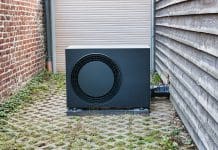You shouldn’t need a degree in thermal engineering to understand which insulation products present the best option, yet sometimes it feels like it
Here, Thermic Technology, an established manufacturer of thin reflective insulation, aims to help specifiers gain a better understanding of Multifoil insulation with answers to some of its most commonly asked questions.
So how does multifoil insulation work?
It’s not magic but multifoil insulation controls the three mechanisms of heat transfer; radiation, conduction and convection. The low emissivity outer layers reflect up to 95% of infra-red radiation back into the house and prevent the house from emitting infrared radiation to the outside. At the same time, the fibrous insulation core reduces heat loss through conduction and convection.
Multifoil insulation also controls air and vapour movement and as the product is installed across rafters or timber studs it acts as a thermal break and reduces continuous cold bridging.
How is this different to traditional insulation?
Rigid board and fibre insulation are both good at controlling heat loss, but that is all they do.
They don’t control air movement and they don’t control water vapour. By controlling heat, air and vapour movement in one, multifoils address all the needs of the building.
Are multifoils accepted by building control?
LABC has embraced the correct use of multifoil insulation and a number of products, including PhotonAir and PhotonFoil, have been registered within the LABC Registered Detail scheme ensuring their acceptance by building control across England and Wales.
Can multifoil insulation meet new build regulations on their own?
No. There is no multifoil product that will meet current new-build regulations by itself – all will need to be used with additional insulation, for example PhotonFoil with 65mm PIR will achieve a U-value of 0.18 W/m2.K in a pitched roof.
In refurbishment projects requiring different U-values there may be situations where multifoil insulation is accepted as an upgrade as a single layer. Here, where the standard is not technically, functionally or economically feasible, the thermal element should be upgraded to the best standards achievable – delivering a simple payback of no greater than 15 years. Generally this lesser standard should not be worse than 0.7w/m2.k. PhotonAir (an insulating breather membrane) can achieve a U-value of 0.60 in 75mm rafter at 400mm spacing.
It is advisable in these circumstances to consult with your local building control officer.
What goes on the warm side/cold side?
Vapour barrier multifoils, such as PhotonFoil will go on the inside of a roof while breathable products, such as PhotonAir, will go on the outside of a building. In simple terms, it’s about preventing water vapour getting into the cavity, but, if it does, it needs a mechanism to escape or it runs the risk of developing harmful condensation.
Remember vapour barrier on the warm side, breathable on the cold side.
Why do I need airgaps and what is optimum?
Airgaps are needed for thermal performance and the optimum is 20mm but it can be less with a small reduction in the R value.
Do airgaps need to be ventilated to reduce condensation risk?
No, they should be unventilated or the thermal benefit won’t be achieved. All our accepted solutions have condensation risk analysis so they can be used with confidence. Again remember the rule: vapour barrier on the warm side, breathable on the cold side.
If I only have one airgap does this give me a condensation risk?
No it doesn’t but it will drop the thermal performance. All PhotonFoil and PhotonAir Registered Details have been independently assessed by LABC to ensure they deliver the necessary thermal performance.
What batten sizes do I need?
The Photon range, being 33mm thick, needs a 38mm batten to provide the optimum airgap. Thicker products do however need bigger battens to achieve the optimum airgap, for example a 40mm thick multifoil typically needs a 50mm batten and 50mm thick multifoil a 70mm batten!
For anything thicker than this then the question is `is it practical or really space saving?’.
Overlapping and taping?
It is important to tape vapour barrier multifoils as this ensures the integrity of the air and vapour barrier.
Most multifoils also need to be overlapped by 50mm before taping. This creates double thickness of material under battens whereas to overcome this PhotonFoil includes 50mm flaps on all sides, allowing the product to be butted up to itself. This improves the yield whilst removing the need to have a double thickness on material under a batten.
PhotonAir goes further than this as it includes a 150mm roofing membrane overlap, allowing each layer of PhotonAir to butt-join the previous layer. The 150mm membrane overlap runs over the lower layer, ensuring that any water runs down the roof slope without penetrating between layers.
PhotonAir has also been wind uplift tested in accordance with BS5534 and is suitable for all zones 1-5 without the need for taping.
What makes PhotonAir more breathable than the others?
A unique feature of PhotonAir is that it is air-open which makes it more breathable than other insulating breather membranes (air-open membranes allow more water vapour to pass than air-closed). NHBC accepts the use of membranes certified as both air and vapour-open without the requirement for supporting ridge or high level ventilation.
Why does the Photon range use a glass wool core?
Glasswool delivers a trusted thermal performance with an established λ90/90 value and a better thermal performance (lower λ) than polyester based multifoils. The product is fire resistance (A1 non-combustible), easier to cut than traditional multifoils, screws without snagging and is a cost effective insulation solution.
What’s the future for reflective insulation?
The future is actually now and it’s here with our PhotonAir insulating breather membrane!
Thermic Technology is a British-based company which specialises in the design and manufacture of thin reflective insulation for the professional and self-build markets. Its people have been at the forefront of the multifoil insulation industry since 2006 and understand how to create cost effective, thermally enhanced insulation products.
Further information about the Photon range and Thermic Technology visit www.thermictechnology.co.uk.
Thermic Technology Ltd
Moorland Gate Business Park
Chorley
Lancashire PR6 9FE
Tel: 01257 241084













